Using Multi-Spectral Remote Sensing for Flood Mapping: A Case Study in Lake Vembanad, India
Abstract
:1. Introduction
2. Materials and Methods
2.1. Study Area
2.2. Multi-Spectral Remote Sensing Observations
2.3. Water Index Algorithms
2.4. Sentinel-2 Flood Mapping
2.5. Synthetic-Aperture Radar Observations
2.6. Sentinel-1 Flood Mapping
2.7. Accuracy Analysis
2.8. Verification of Satellite-Based Flood Maps
2.9. Ancillary Data
3. Results
3.1. Application of Sentinel-2 Data for Flood Mapping
3.2. Comparison of Sentinel-1 and -2 Flood Mapping
3.3. August 2018 Floods
3.4. Effect of Waterlogged Paddy Fields on Flood Mapping
3.5. Effect of Cloud Cover on Sentinel-2 Flood Mapping
4. Discussion
5. Conclusions
Supplementary Materials
Author Contributions
Funding
Data Availability Statement
Conflicts of Interest
References
- CRED Disaster Year in Review 2019. CRED Crunch 2020, 1–2. Available online: https://cred.be/sites/default/files/CC58.pdf (accessed on 22 May 2022).
- CRED 2021 Disasters in Numbers; Brussels. 2021. Available online: https://cred.be/sites/default/files/2021_EMDAT_report.pdf (accessed on 22 May 2022).
- Lee, J.; Perera, D.; Glickman, T.; Taing, L. Water-Related Disasters and Their Health Impacts: A Global Review. Prog. Disaster Sci. 2020, 8, 100123. [Google Scholar] [CrossRef]
- UN Sustainable Development Goals. Available online: https://sdgs.un.org/ (accessed on 12 August 2022).
- Menon, N.N.; Balchand, A.N.; Menon, N.R. Hydrobiology of the Cochin Backwater System—A Review. Hydrobiologia 2000, 430, 149–183. [Google Scholar] [CrossRef]
- WISA Conservation and Wise Use of Vemabanad-Kol: An Integrated Management Planning Framework; New Delhi, India. 2013. Available online: https://www.mangrovesforthefuture.org/assets/Repository/Documents/Wetlands-International-SGP-Final-report.pdf (accessed on 12 November 2020).
- Gopalan, U.K.; Vengayil, D.T.; Udayavarma, P.; Krishnankutty, M. The Shrinking Backwaters of Kerala. J. Mar. Biol. Ass. India 1983, 25, 131–141. [Google Scholar]
- Balachandran, K.K.; Nair, K.K.C.; Achuthankutty, C.T.; Nair, S.; Wafar, M.V.W.; Ramesh; Saramma, U.P.; Rosamma, S.; Haridas, P.; Jayalakshmy, K.V.; et al. Ecosystem Modelling of Cochin Backwaters 2002–2007; Ministry of Earth Sciences, Government of India: New Delhi, India, 2007. [Google Scholar]
- Vincy, M.V.; Rajan, B.; Pradeep, P.K.A. Water Quality Assessment of a Tropical Wetland Ecosystem with Special Reference to Backwater Tourism, Kerala, South India. Int. Res. J. Environ. Sci. 2012, 1, 62–68. [Google Scholar]
- Kulk, G.; George, G.; Abdulaziz, A.; Menon, N.; Theenathayalan, V.; Jayaram, C.; Brewin, R.J.W.; Sathyendranath, S. Effect of Reduced Anthropogenic Activities on Water Quality in Lake Vembanad, India. Remote Sens. 2021, 13, 1631. [Google Scholar] [CrossRef]
- Abdulaziz, A.; Krishna, K.; Syamkumar, V.; George, G.; Menon, N.; Kulk, G.; Jasmin, C.; Ciambelli, A.; Hridya, K.V.; Tharakan, B.; et al. Dyanmics of Vibrio Cholera in a Typical Tropical Lake and Estuarine System: Potential of Remote Sensing for Risk Mapping. Remote Sens. 2021, 13, 1034. [Google Scholar] [CrossRef]
- Abdulaziz, A.; Sathyendranath, S.; Vijayakumar, S.K.; Menon, N.; George, G.; Kulk, G.; Raj, D.; Krishna, K.; Rajamohananpillai, R.; Tharakan, B.; et al. The Distribution of Fecal Contamination in an Urbanized Tropical Lake and Incidence of Acute Diarrheal Disease. ACS EST Water 2023, 3, 1561–1573. [Google Scholar] [CrossRef]
- CRED Natural Disasters 2018; Brussels. 2018. Available online: https://emdat.be/sites/default/files/adsr_2018.pdf (accessed on 22 May 2022).
- Act!onaid Emergency Response to Kerala Floods 2018; New Delhi. 2018. Available online: https://www.actionaidindia.org/wp-content/uploads/2019/07/Kerala-Floods-Emergency-2018-Report-Jul1519-l-Web.pdf (accessed on 16 August 2022).
- Oddo, P.C.; Bolten, J.D. The Value of Near Real-Time Earth Observations for Improved Flood Disaster Response. Front. Environ. Sci. 2019, 7, 1–11. [Google Scholar] [CrossRef]
- Schumann, G.; Moller, D. Microwave Remote Sensing of Flood Inundation. Phys. Chem. Earth 2015, 83–84, 84–95. [Google Scholar] [CrossRef]
- Fischell, L.; Lüdtke, D.; Duguru, M. Capabilities of SAR and Optical Data for Rapid Mapping of Flooding Events. United Nations Platform for Space-based information for Disaster Management and Emergency Response. Bonn. 2018. Available online: https://geomundus.org/2018/docs/papers/Lisa.pdf (accessed on 3 August 2022).
- Vishnu, C.L.; Sajinkumar, K.S.; Oommen, T.; Coffman, R.A.; Thrivikramji, K.P.; Rani, V.R.; Keerthy, S. Satellite-Based Assessment of the August 2018 Flood in Parts of Kerala, India. Geomat. Nat. Hazards Risk 2019, 10, 758–767. [Google Scholar] [CrossRef]
- Tiwari, V.; Kumar, V.; Matin, M.A.; Thapa, A.; Ellenburg, W.L.; Gupta, N.; Thapa, S. Flood Inundation Mapping-Kerala 2018; Harnessing the Power of SAR, Automatic Threshold Detection Method and Google Earth Engine. PLoS ONE 2020, 15, e0237324. [Google Scholar] [CrossRef] [PubMed]
- Vanama, V.S.K.; Rao, Y.S.; Bhatt, C.M. Change Detection Based Flood Mapping Using Multi-Temporal Earth Observation Satellite Images: 2018 Flood Event of Kerala, India. Eur. J. Remote Sens. 2021, 54, 42–58. [Google Scholar] [CrossRef]
- Vanama, V.S.K.; Musthafa, M.; Khati, U.; Gowtham, R.; Singh, G.; Rao, Y.S. Inundation Mapping of Kerala Flood Event in 2018 Using ALOS-2 and Temporal Sentinel-1 SAR Images. Curr. Sci. 2021, 120, 915–925. [Google Scholar] [CrossRef]
- Huang, C.; Chen, Y.; Zhang, S.; Wu, J. Detecting, Extracting, and Monitoring Surface Water From Space Using Optical Sensors: A Review. Rev. Geophys. 2018, 56, 333–360. [Google Scholar] [CrossRef]
- Notti, D.; Giordan, D.; Caló, F.; Pepe, A.; Zucca, F.; Galve, J.P. Potential and Limitations of Open Satellite Data for Flood Mapping. Remote Sens. 2018, 10, 1673. [Google Scholar] [CrossRef]
- Mateo-Garcia, G.; Veitch-Michaelis, J.; Smith, L.; Oprea, S.V.; Schumann, G.; Gal, Y.; Baydin, A.G.; Backes, D. Towards Global Flood Mapping Onboard Low Cost Satellites with Machine Learning. Sci. Rep. 2021, 11, 7429. [Google Scholar] [CrossRef]
- Albertini, C.; Gioia, A.; Ioacobellis, V.; Manfreda, S. Detection of Surface Water and Floods with Multispectral Satellites. Remote Sens. 2022, 14, 6005. [Google Scholar] [CrossRef]
- Yang, H.; Wang, Z.; Zhao, H.; Guo, Y. Water Body Extraction Methods Study Based on RS and GIS. Procedia Environ. Sci. 2011, 10, 2619–2624. [Google Scholar] [CrossRef]
- McFeeters, S.K. The Use of the Normalized Difference Water Index (NDWI) in the Delineation of Open Water Features. Int. J. Remote Sens. 1996, 17, 1425–1432. [Google Scholar] [CrossRef]
- Xu, H. Modification of Normalised Difference Water Index (NDWI) to Enhance Open Water Features in Remotely Sensed Imagery. Int. J. Remote Sens. 2006, 27, 3025–3033. [Google Scholar] [CrossRef]
- Feyisa, G.L.; Meilby, H.; Fensholt, R.; Proud, S.R. Automated Water Extraction Index: A New Technique for Surface Water Mapping Using Landsat Imagery. Remote Sens. Environ. 2014, 140, 23–35. [Google Scholar] [CrossRef]
- Lakshmanan, P.T.; Shynamma, C.S.; Balchand, A.N.; Kurup, P.G.; Nambisan, P.N.K. Distribution and Seasonal Variation of Temperature and Salinity in Cochin Backwaters. Indian J. Mar. Sci. 1982, 11, 170–172. [Google Scholar]
- Gopakumar, R. Characteristics of Floods in the Vembanad Wetlands and Possible Measures for Flood Management in the Region. In Advances in Geosciences; Lin, G.-F., Ed.; Hydrological Science; World Scientific Publishers: Singapore, 2011; Volume 23, pp. 9–22. [Google Scholar] [CrossRef]
- Kannan, K.P. Ecological and socio-economic consequences of water-control projects in the Kuttanad region of Kerala. Proc. Indian Acad. Sci. 1979, 2, 417–433. [Google Scholar] [CrossRef]
- Shiyam Sundar, P.K.; Kundapura, S. Spatial Mapping of Flood Susceptibility Using Decision Tree–Based Machine Learning Models for the Vembanad Lake System in Kerala, India. J. Water Resour. Plan. Manag. 2023, 149, 10. [Google Scholar] [CrossRef]
- Remani, K.N.; Jayakumar, P.; Jalaja, T.K. Environmental problems and management aspects of Vembanad Kol wetlands in south west coast of India. Nat. Environ. Pollut. Technol. 2010, 9, 247–254. [Google Scholar]
- Vanhellemont, Q.; Ruddick, K. ACOLITE For Sentinel-2: Aquatic Applications of MSI Imagery. In Proceedings of the 2016 ESA Living Planet Symposium, Prague, Czech Republic, 9–12 May 2016; ESA Special Publication: Prague, Czech Republic, 2016; p. SP-740. [Google Scholar]
- Vanhellemont, Q.; Ruddick, K. Atmospheric Correction of Metre-Scale Optical Satellite Data for Inland and Coastal Water Applications. Remote Sens. Environ. 2018, 216, 586–597. [Google Scholar] [CrossRef]
- Vanhellemont, Q.; Ruddick, K. Adaptation of the Dark Spectrum Fitting Atmospheric Correction for Aquatic Applications of the Landsat and Sentinel-2 Archives. Remote Sens. Environ. 2019, 225, 175–192. [Google Scholar] [CrossRef]
- Shen, L.; Li, C. Water Body Extraction from Landsat ETM+ Imagery Using Adaboost Algorithm. In Proceedings of the 18th International Conference on Geoinformatics, Beijing, China, 18–20 June 2010; pp. 1–4. [Google Scholar]
- Asmadin; Siregar, V.P.; Sofian, I.; Jaya, I.; Wijanarto, A.B. Feature Extraction of Coastal Surface Inundation via Water Index Algorithms Using Multispectral Satellite on North Jakarta. IOP Conf. Ser. Earth Environ. Sci. 2018, 176. [Google Scholar] [CrossRef]
- Kussul, N.; Shelestov, A.; Skakun, S. Flood Monitoring from SAR Data. NATO Sci. Peace Secur. Ser. C Environ. Secur. 2011, 97, 19–29. [Google Scholar] [CrossRef]
- Funk, C.; Peterson, P.; Landsfeld, M.; Pedreros, D.; Verdin, J.; Shukla, S.; Husak, G.; Rowland, J.; Harrison, L.; Hoell, A.; et al. The Climate Hazards Infrared Precipitation with Stations—A New Environmental Record for Monitoring Extremes. Sci. Data 2015, 2, 150066. [Google Scholar] [CrossRef]
- Lal, P.; Prakash, A.; Kumar, A.; Srivastava, P.K.; Saikia, P.; Pandey, A.C.; Srivastava, P.; Khan, M.L. Evaluating the 2018 Extreme Flood Hazard Events in Kerala, India. Remote Sens. Lett. 2020, 11, 436–445. [Google Scholar] [CrossRef]
- Murali, R.; Kumar, P. Implications of Sea Level Rise Scenarios on Land Use/Land Cover Classes of the Coastal Zones of Cochin, India. J. Environ. Manag. 2015, 148, 124–133. [Google Scholar] [CrossRef] [PubMed]
- Ramakrishnan, R.; Remya, P.G.; Mandal, A.; Mohanty, P.; Arayakandy, P.; Mahendra, R.S.; Nair, T.M.B. Wave Induced Coastal Flooding along the Southwest Coast of India during Tropical Cyclone Tauktae. Sci. Rep. 2022, 12, 19966. [Google Scholar] [CrossRef] [PubMed]
- Acharya, T.D.; Subedi, A.; Lee, D.H. Evaluation of Water Indices for Surface Water Extraction in a Landsat 8 Scene of Nepal. Sensors 2018, 18, 2580. [Google Scholar] [CrossRef] [PubMed]
- Konapala, G.; Kumar, S.V.; Khalique Ahmad, S. Exploring Sentinel-1 and Sentinel-2 Diversity for Flood Inundation Mapping Using Deep Learning. ISPRS J. Photogramm. Remote Sens. 2021, 180, 163–173. [Google Scholar] [CrossRef]
- Huang, L.Y.; Wang, Y.C.; Wu, C.C.; Chen, Y.C.; Huang, Y.L. Risk of Flood-Related Diseases of Eyes, Skin and Gastrointestinal Tract in Taiwan: A Retrospective Cohort Study. PLoS ONE 2016, 11, e0155166. [Google Scholar] [CrossRef] [PubMed]
- Manavalan, R. SAR Image Analysis Techniques for Flood Area Mapping—Literature Survey. Earth Sci. Inform. 2017, 10, 1–14. [Google Scholar] [CrossRef]
- Ryu, J.H.; Won, J.S.; Min, K.D. Waterline Extraction from Landsat TM Data in a Tidal Flat a Case Study in Gomso Bay, Korea. Remote Sens. Environ. 2002, 83, 442–456. [Google Scholar] [CrossRef]
- Cao, H.; Zhang, H.; Wang, C.; Zhang, B. Operational Flood Detection Using Sentinel-1 SAR Data over Large Areas. Water 2019, 11, 786. [Google Scholar] [CrossRef]
- Sherpa, S.F.; Shirzaei, M.; Ojha, C.; Werth, S.; Hostache, R. Probabilistic Mapping of August 2018 Flood of Kerala, India, Using Space-Borne Synthetic Aperture Radar. IEEE J. Sel. Top. Appl. Earth Obs. Remote Sens. 2020, 13, 896–913. [Google Scholar] [CrossRef]
- Alsdorf, D.; Rodriguez, E.; Lettenmaier, D. Measuring Surface Water from Space. Rev. Geophys. 2007, 45, 123. [Google Scholar] [CrossRef]
- Mason, D.C.; Giustarini, L.; Garcia-Pintado, J.; Cloke, H.L. Detection of Flooded Urban Areas in High Resolution Synthetic Aperture Radar Images Using Double Scattering. Int. J. Appl. Earth Obs. Geoinf. 2014, 28, 150–159. [Google Scholar] [CrossRef]
- Nair, L.; Balan, S. Recent Floods in Kerala and Its Impact on Rice Yield in Kuttanad—A Retrospective Analysis. Mausam 2022, 73, 689–694. [Google Scholar] [CrossRef]
- Theenathayalan, V.; Sathyendranath, S.; Kulk, G.; Menon, N.; George, G.; Abdulaziz, A.; Selmes, N.; Brewin, R.J.W.; Rajendran, A.; Xavier, S.; et al. Regional Satellite Algorithms to Estimate Chlorophyll-a and Total Suspended Matter Concentrations in Vembanad Lake. Remote Sens. 2022, 14, 6404. [Google Scholar] [CrossRef]
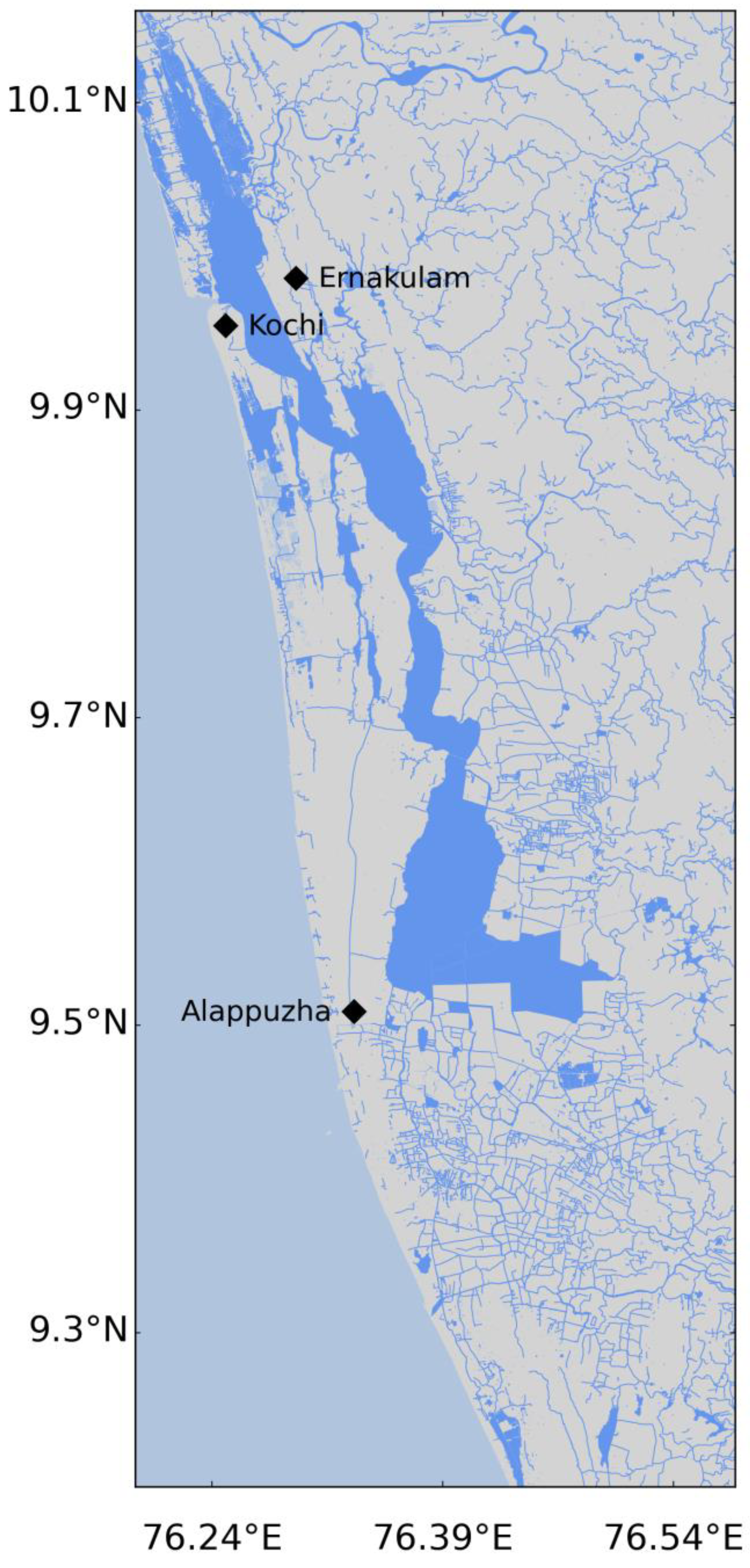
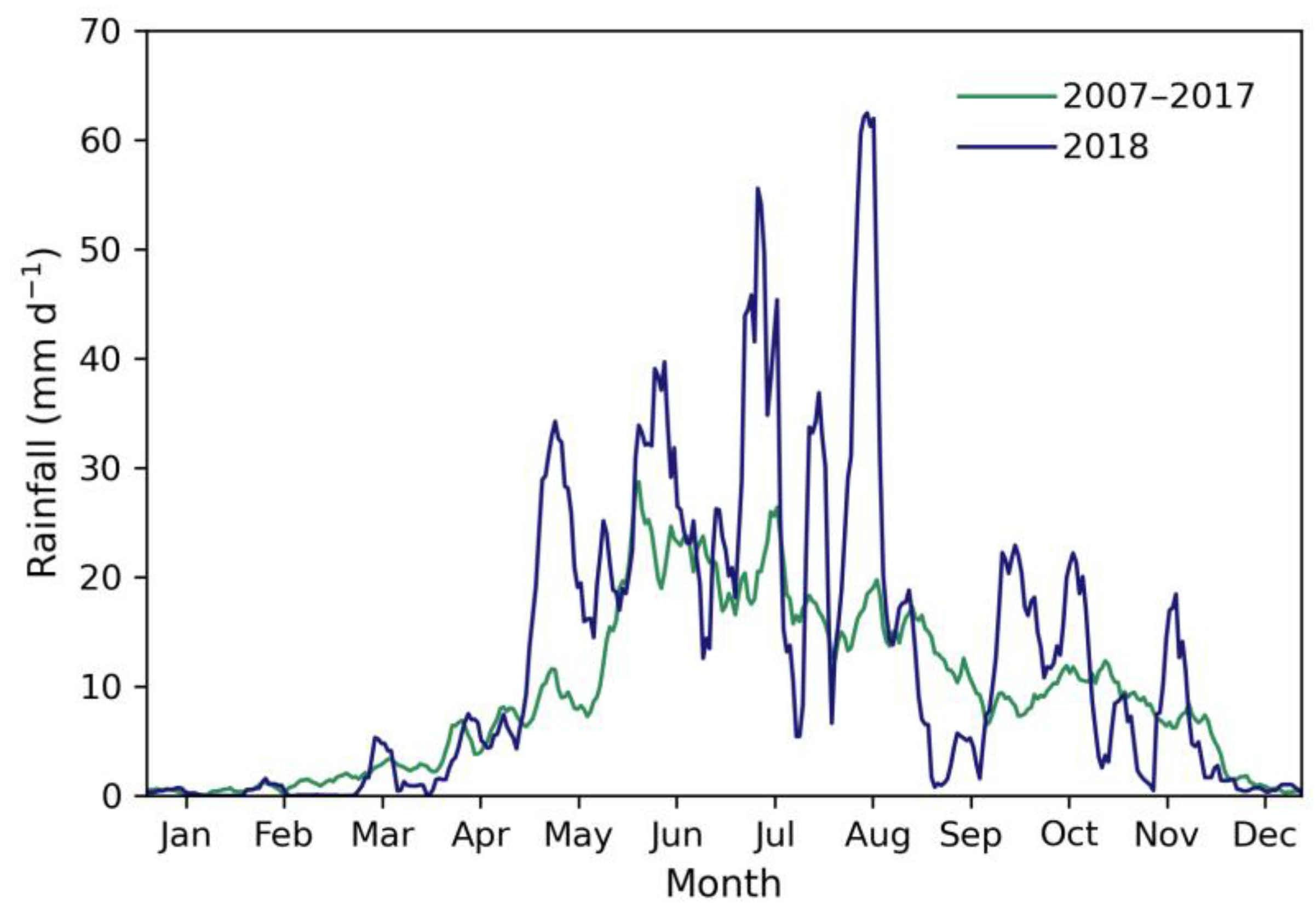

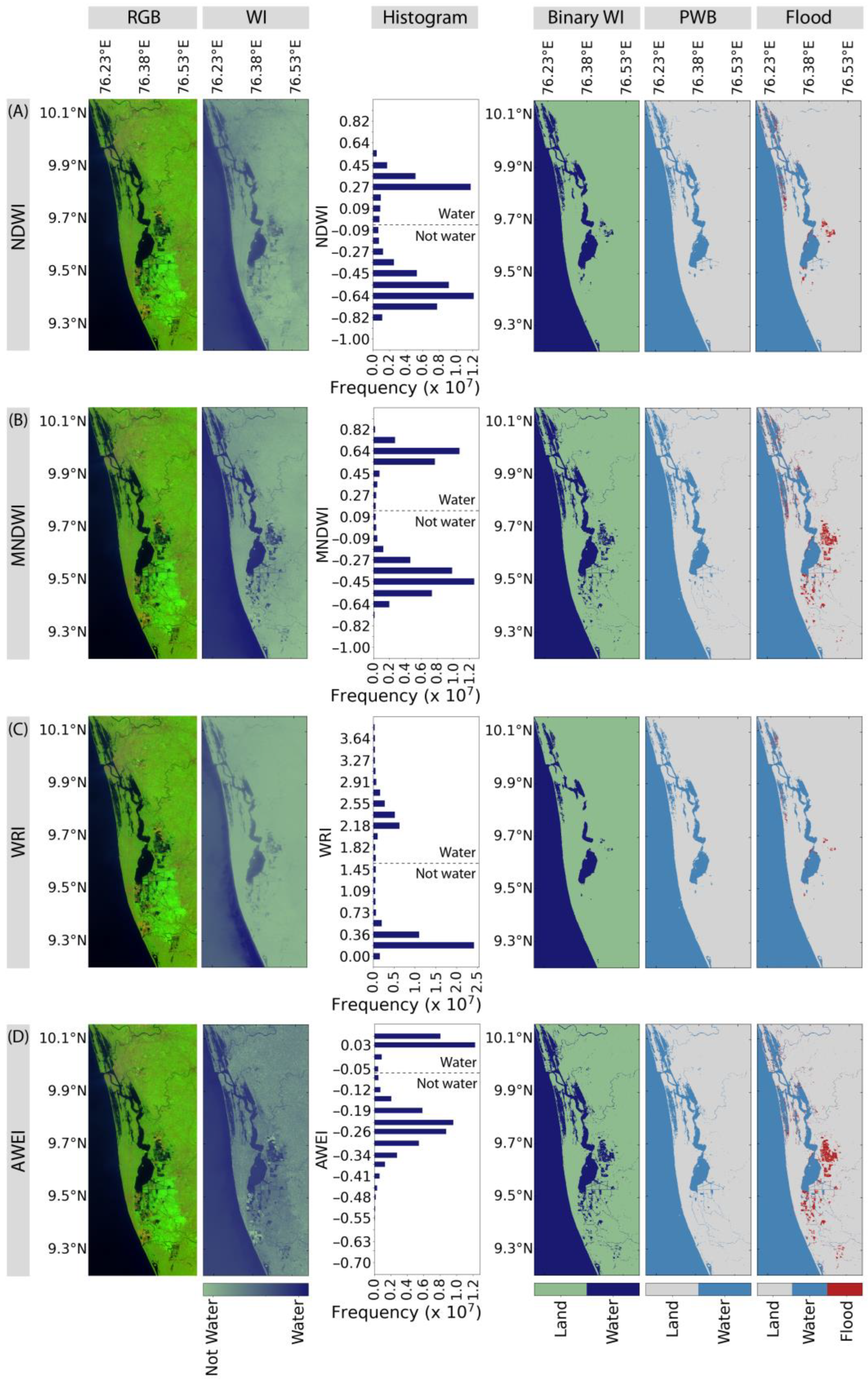
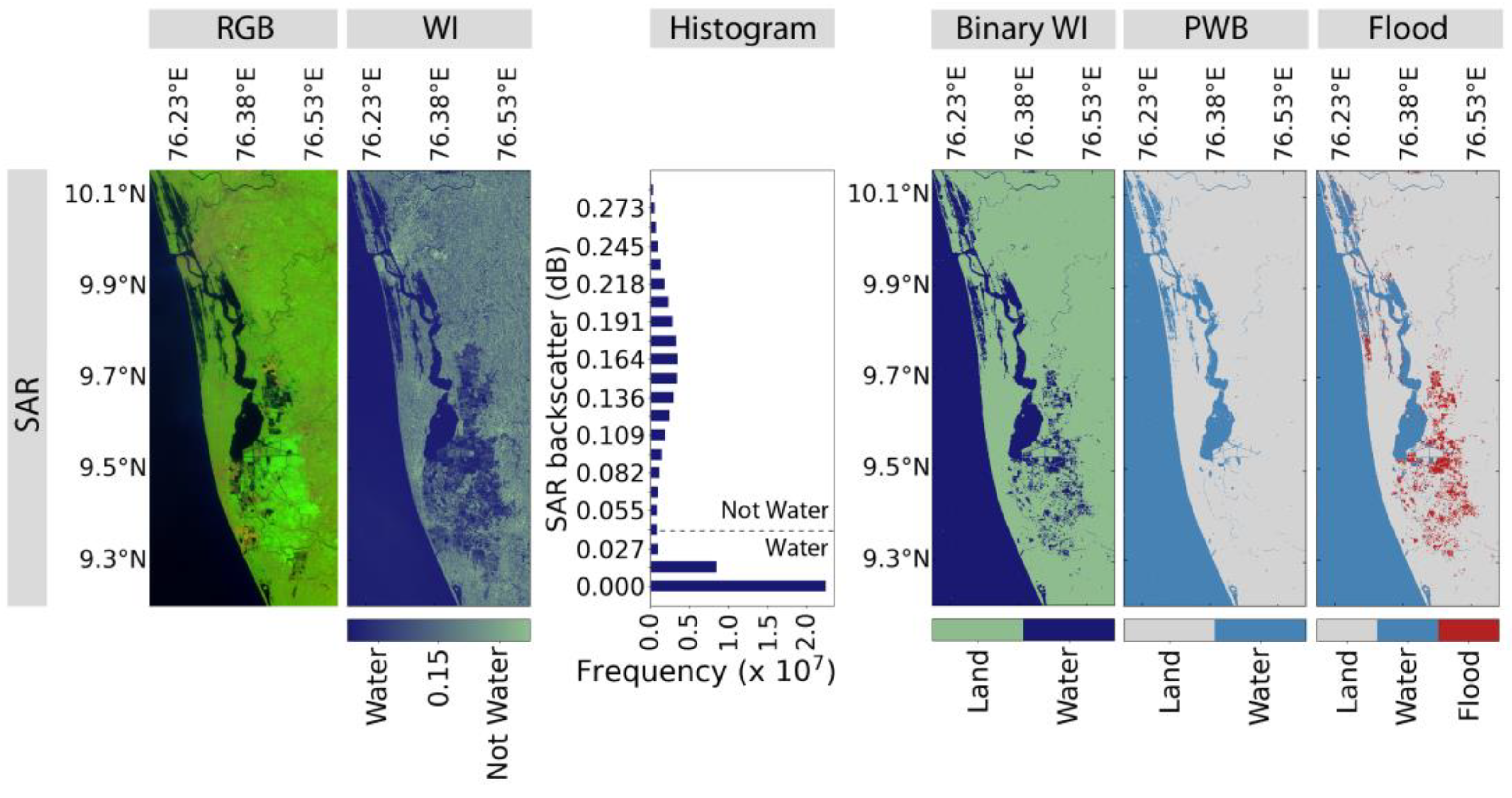
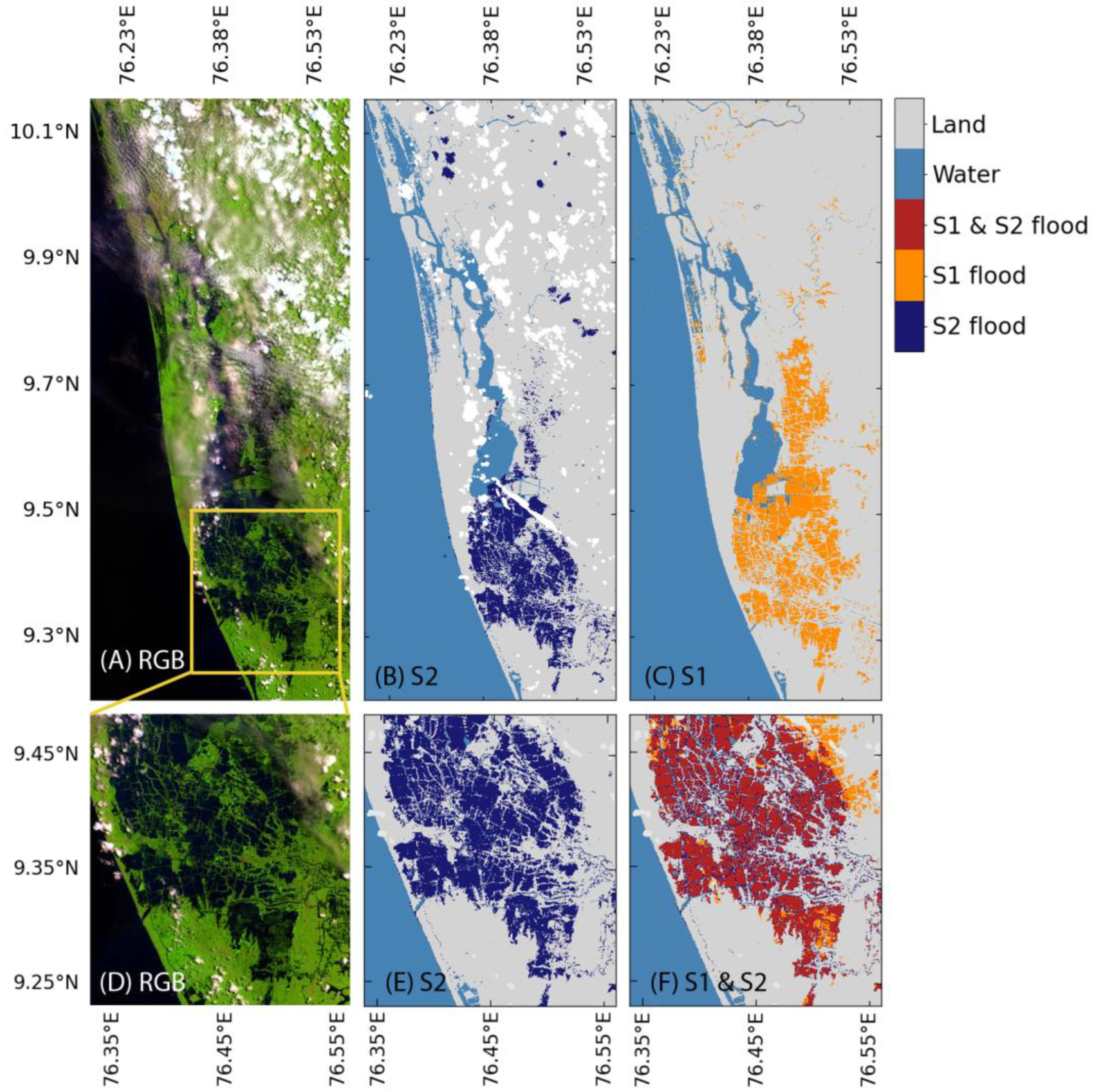
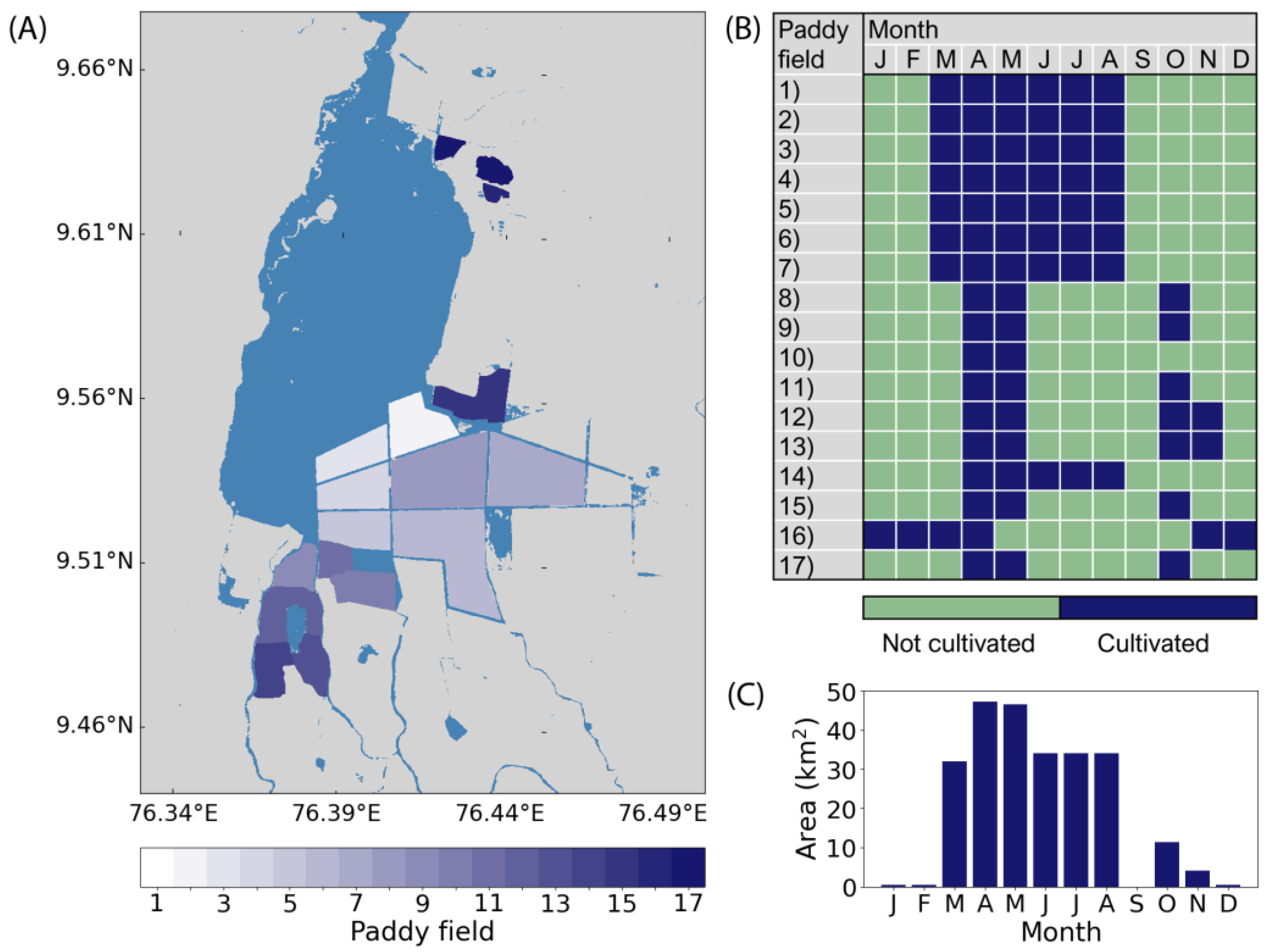

| Lake Vembanad | Southern Region | ||||
|---|---|---|---|---|---|
| PWB Map | Flood Map January 2018 | Flood Map August 2018 | PWB Map | Flood Map August 2018 | |
| NDWI | 267 | 38 | 484 | 3.00 | 214 |
| MNDWI | 306 | 111 | 377 | 8.76 | 225 |
| WRI | 224 | 16 | 236 | 2.07 | 183 |
| AWEI | 353 | 132 | 417 | 14.5 | 261 |
| S1 | 285 | 168 | 448 | 7.80 | 197 |
| PWB Map | Flood Map January 2018 | ||||||||
|---|---|---|---|---|---|---|---|---|---|
| NDWI | MNDWI | WRI | AWEI | NDWI | MNDWI | WRI | AWEI | ||
| Producer’s accuracy | Water | 99.2 | 98.9 | 99.6 | 98.0 | 97.3 | 96.9 | 95.7 | 94.7 |
| Non-water | 87.5 | 94.7 | 80.4 | 97.3 | 52.8 | 58.4 | 50.9 | 57.5 | |
| User’s accuracy | Water | 85.8 | 94.5 | 75.7 | 97.3 | 10.8 | 29.4 | 3.6 | 27.1 |
| Non-water | 99.3 | 99.0 | 99.7 | 98.0 | 99.7 | 99.1 | 99.8 | 98.5 | |
| Overall accuracy | 92.6 | 96.7 | 87.7 | 97.7 | 55.2 | 64.2 | 51.7 | 62.8 | |
| Critical Success Index | 85.3 | 93.5 | 75.5 | 95.4 | 10.7 | 29.1 | 3.6 | 26.7 | |
| Kappa Coefficient | 85.2 | 93.5 | 75.4 | 95.3 | 10.5 | 45.1 | 3.4 | 25.9 | |
| PWB Map | Flood Map August 2018 | ||
|---|---|---|---|
| Producer’s accuracy | Water | 99.5 | 86.6 |
| Non-water | 82.2 | 85.0 | |
| User’s accuracy | Water | 78.4 | 84.7 |
| Non-water | 99.6 | 86.9 | |
| Overall accuracy | 89.0 | 85.8 | |
| Critical Success Index | 78.1 | 74.9 | |
| Kappa Coefficient | 78.1 | 71.6 |
| Paddy Field | Season | Latitude | Longitude | Area (km2) |
|---|---|---|---|---|
| (1) Chithira | Puncha | 9.55 | 76.42 | 3.07 |
| (2) Rani | Puncha | 9.54 | 76.39 | 2.42 |
| (3) Marthandam | Puncha | 9.53 | 76.39 | 2.78 |
| (4) C-Block | Puncha | 9.52 | 76.41 | 2.75 |
| (5) D-Block | Puncha | 9.51 | 76.42 | 7.52 |
| (6) H-Block | Puncha | 9.54 | 76.45 | 6.24 |
| (7) R-Block | Puncha | 9.54 | 76.42 | 6.63 |
| (8) Kuppapuram | Puncha, Virippu | 9.51 | 76.38 | 1.59 |
| (9) Aarupank | Puncha, Virippu | 9.50 | 76.40 | 2.25 |
| (10) Cherukalikayal | Puncha, Virippu | 9.51 | 76.39 | 1.17 |
| (11) Kanakassery, Meenappally, Valiyeri | Puncha, Virippu | 9.49 | 76.37 | 2.74 |
| (12) Romana | Puncha, Virippu | 9.48 | 76.38 | 1.68 |
| (13) Puthanthuram | Puncha, Virippu | 9.48 | 76.37 | 1.92 |
| (14) Pallikayal | Puncha (Virippu) | 9.56 | 76.42 | 2.67 |
| (15) Vaddake pallipadam | Puncha, Virippu | 9.63 | 76.43 | 0.34 |
| (16) Malikayal chira | Virippu | 9.64 | 76.42 | 0.55 |
| (17) Vattakayal thattepadam | Puncha, Virippu | 9.63 | 76.43 | 0.84 |
Disclaimer/Publisher’s Note: The statements, opinions and data contained in all publications are solely those of the individual author(s) and contributor(s) and not of MDPI and/or the editor(s). MDPI and/or the editor(s) disclaim responsibility for any injury to people or property resulting from any ideas, methods, instructions or products referred to in the content. |
© 2023 by the authors. Licensee MDPI, Basel, Switzerland. This article is an open access article distributed under the terms and conditions of the Creative Commons Attribution (CC BY) license (https://creativecommons.org/licenses/by/4.0/).
Share and Cite
Kulk, G.; Sathyendranath, S.; Platt, T.; George, G.; Suresan, A.K.; Menon, N.; Evers-King, H.; Abdulaziz, A. Using Multi-Spectral Remote Sensing for Flood Mapping: A Case Study in Lake Vembanad, India. Remote Sens. 2023, 15, 5139. https://doi.org/10.3390/rs15215139
Kulk G, Sathyendranath S, Platt T, George G, Suresan AK, Menon N, Evers-King H, Abdulaziz A. Using Multi-Spectral Remote Sensing for Flood Mapping: A Case Study in Lake Vembanad, India. Remote Sensing. 2023; 15(21):5139. https://doi.org/10.3390/rs15215139
Chicago/Turabian StyleKulk, Gemma, Shubha Sathyendranath, Trevor Platt, Grinson George, Anagha Kunhimuthappan Suresan, Nandini Menon, Hayley Evers-King, and Anas Abdulaziz. 2023. "Using Multi-Spectral Remote Sensing for Flood Mapping: A Case Study in Lake Vembanad, India" Remote Sensing 15, no. 21: 5139. https://doi.org/10.3390/rs15215139








